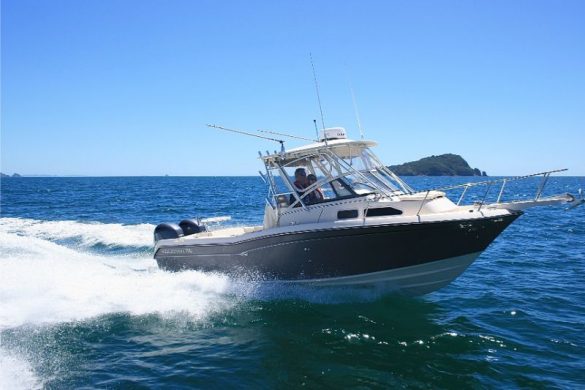Ooh la la!
Stuart Arnold, a man who speaks with a distinctive English accent, has taken an American icon, Kiwi-fied it and created something very special. Or, as the young kid on the shore put it so succinctly: “Ooh la la!”
We were in the Coromandel township of Tairua, returning down the narrow channel to the marina, and very close to the shore. The youngster was playing in the shallows with his mother, just metres away, and his spontaneous reaction was not that surprising.
We were in the new “exclusive to New Zealand” Grady-White 258 Journey and, as the accompanying photos show, it is quite a sight: Cape Grey topsides, creamy superstructure, clears-enclosed wheelhouse under a large factory custom hard top, gleaming outriggers and near-silent twin Yamaha 150hp 4-strokes outboards.
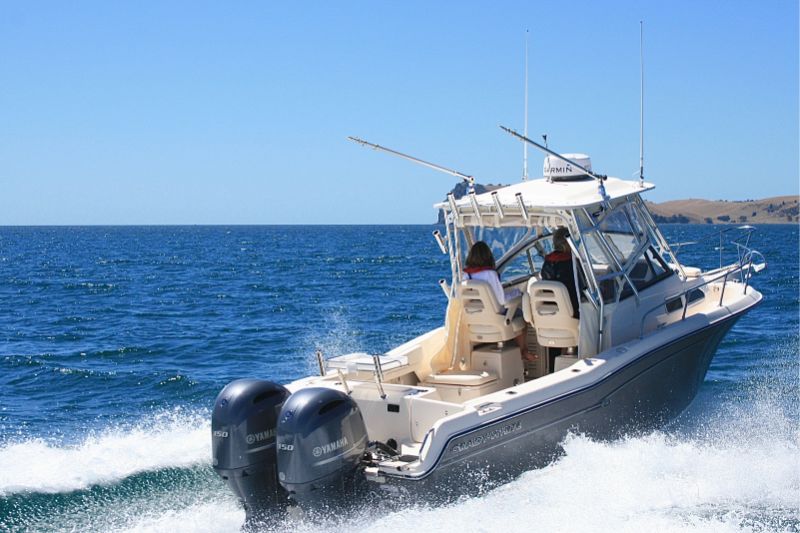

Stuart has been importing Grady-Whites into New Zealand for about 14 months and, while he is not the first to do so, he is certainly the most successful, with seven sold already.
He has now used the knowledge gained in those sales, along with his experience with the brand and those drawn to it, to create a unique model, one available only through him.
The Grady-White Journey 258 Limited Edition is a New Zealand-only Walk Around Cabin, factory finished to Stuart’s very particular specifications. The boat is supplied complete (the 428-litre fuel tanks will be full and the fenders on board) and ready to launch. No time will need to be wasted choosing between a variety of options, Stuart has already done that. Simply stow any personal possessions, turn the keys and go boating.
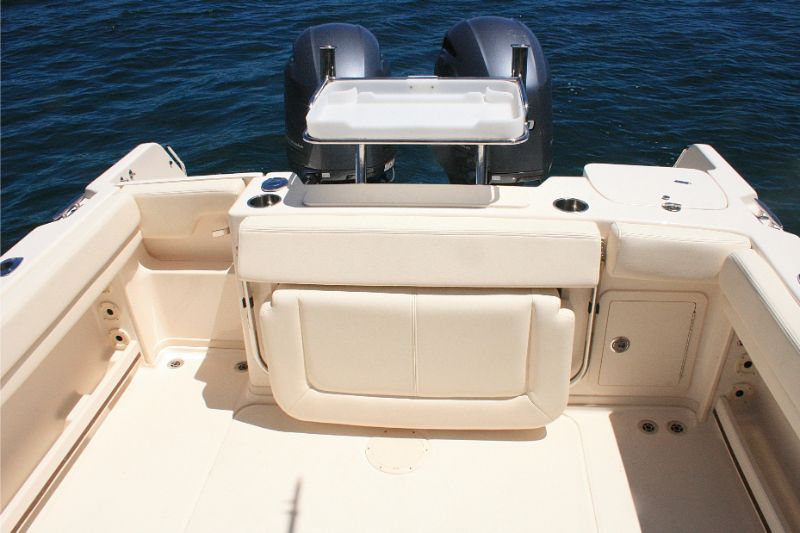
Set up for Kiwis
To make the 258 Journey even more suited to Kiwi boaties, Stuart has up-spec’d virtually every part of what was already a very much top-of-the-line vessel.
On the bow, he has had installed a Lewmar windlass complete with chain and 10-platt multi-braid warp and Rocna anchor. (In the US, with their penchant for simply cruising from one marina to the next, cleats are the preferred foredeck fitting). Another welcome addition is the foredeck cushioning, turning a hard surface into a far softer comfortable one.
In the cabin, the “Porta Potti” has been upgraded to a Jabsco flush toilet. Also modified are the rod-holding brackets, now complete with hinges to make them less obtrusive when not in use.
Under the hard top, Stuart has upgraded the seating to fully adjustable (including armrests) top-of-the-line luxury Pompanette and installed a $15,000 Garmin electronics package. It consists of a 7410xsv display with GPS, 1 kW CHIRP through-hull transducer (complete with side scan sonar), HD radar, autopilot, VHF radio and NZ-wide standard and bathymetric charts. There is also a Fusion stereo system with speakers inside and out and a protective set of fully enclosing strata glass clears.

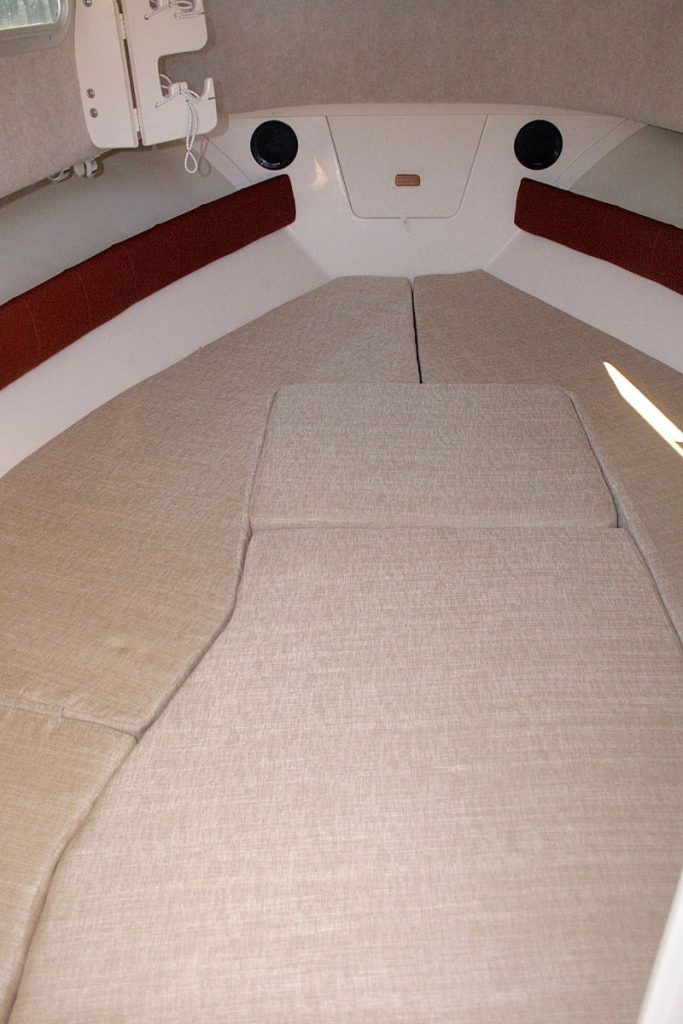
In the cockpit, the “Kiwi-fication” includes a transom door on starboard, which opens outwards rather than in, blue LED lighting under the gunwales and a custom bait board with rod holders. There is also a set of very smart Taco outriggers for those keen to chase bigger fish. Recognising that boating and fishing can be thirsty work, Stuart has also installed additional stainless steel drink holders, meaning that, wherever one decides to perch, a refreshing libation can be close at hand.
Even the Magic Tilt trailer is a step up, and a major one at that. Stuart says the dual axle trailer is 99% aluminium (no welding) with a solid aluminium I-beam and built to the “highest possible spec”. It comes with hydraulic electric braking, has LED lighting and “Kiwi plugs” and is delivered registered and warranted.
The result of all this is a twin-engined (Yamaha 150hp 4-strokes) 8.3m LOA GRP pleasure boat that weighs in (fully fuelled and provisioned) at 3.4 tonnes and costs $NZ269,000 complete.
All of these extras are over and above the standard Grady-White spec, although to be fair, there is little “standard” about anything on board a Grady-White.
Quick examples: twin stainless steel scuppers have been fitted to both aft quarters of the cockpit and they, like all the stainless on board, is US-made 316 marine grade; the platform ladder is a long four-step model able to settle deep into the water for ease of boarding; all cleats are inset.


Focussed on fishing
The Journey 258 has clearly been designed for fishing and for doing that a fair way from home. It’s solid hand laid GRP construction gives it the sort of heft required to ride comfortably through the type of seas likely to be encountered when targeting offshore reefs and the like. The 428-litre fuel tank is large enough to cover around 200 nautical miles at 4000rpm and 26 knots.
The cockpit sides feature deep toe kicks and wide gunwale pads so, regardless of one’s height, it is possible to brace oneself, lean into the fish and go to work.
There are plenty of places on board to stow the bait, the catch and the tackle, too. On the port side of the transom is a fully insulated fish box and there is another, even bigger, set under the helm seat. On port, the under seat space has been used to house a Grady-White-style 7-jet live bait tank. It comes complete with blue lining, blue LED lighting and round corners (to de-stress the fish). The catches, again, are all proper 316 stainless. There are also two tackle drawers on the back of the seats, although the squabs need to be removed to access these easily.


The Journey 258 has clearly been designed for fishing and for doing that a fair way from home. It’s solid hand laid GRP construction gives it the sort of heft required to ride comfortably through the type of seas likely to be encountered when targeting offshore reefs and the like. The 428-litre fuel tank is large enough to cover around 200 nautical miles at 4000rpm and 26 knots.
The cockpit sides feature deep toe kicks and wide gunwale pads so, regardless of one’s height, it is possible to brace oneself, lean into the fish and go to work.
There are plenty of places on board to stow the bait, the catch and the tackle, too. On the port side of the transom is a fully insulated fish box and there is another, even bigger, set under the helm seat. On port, the under seat space has been used to house a Grady-White-style 7-jet live bait tank. It comes complete with blue lining, blue LED lighting and round corners (to de-stress the fish). The catches, again, are all proper 316 stainless. There are also two tackle drawers on the back of the seats, although the squabs need to be removed to access these easily.
Under the Hard Top
The high level of appointment continues under the hard top with solid handrails throughout, 12v DC sockets serving both driver and crew and handy inspection hatches.
The helm station features carbon fibre panels behind the Yamaha digital engine gauges, the Garmin MFD and the DC panel. This latter, rather than being on the dash or “around the corner” at the entrance to the cabin, is instead inset into the side bulkhead, close to the driver’s right hand. Its rocker switches have also been thoughtfully ordered with the ones likely to be used the most the closest to hand.
That type of attention to detail is typical of Grady-White’s design and is evident in all sorts of places. For example, the large twin lockers above the station (in which Stuart has housed the VHF) have been pre-wired with junction boxes so installing anything electrical here is a quick and easy operation. They have also been fitted with inertia hinges so they can stay open even while underway in moderate seas. And, like all the hatches on board, they are lockable.

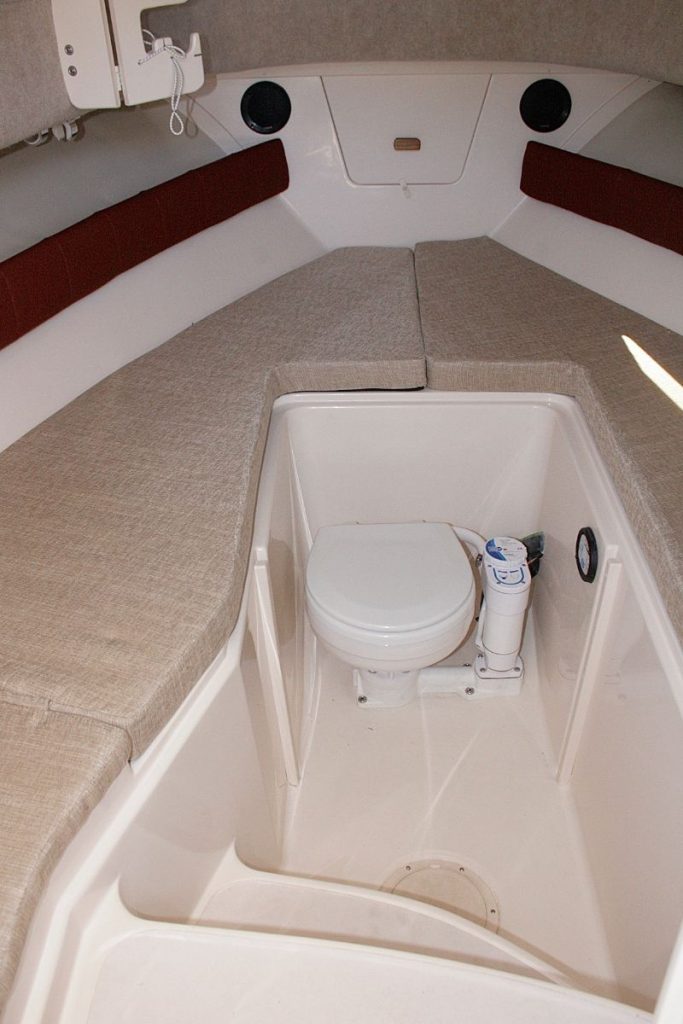
Another instance: the clears surrounding the “bridge” area are inside the hardtop supports. This enables the stainless steel uprights to be used as hand holds when going forward and means they are out of the way when deploying the outriggers.
Another typical Grady-White touch is the lifejacket net stowage pocket on the underside of the hardtop. Close at hand and easy to access, it even comes in two versions: a black and a beige so the owner can choose which they prefer.
With its upgraded Pompanette chairs this is a very well laid out and comfortable area. There is only one thing I would like to change. The passenger side footrest, a teak and stainless construct on the front edge of the seat pedestal, has metal edges. On several occasions, I came very close to removing skin on this and was constantly wary when around it. Considering the detailed thought that has obviously gone into every other part of the boat, it struck a jarring note.
The 258 Journey’s cabin can be configured in three ways: as a standard cabin with seating; as a giant berth or as a head, complete with small sink, foldaway faucet and an enclosing door arrangement for privacy.
There is the standard dry stowage under the bunks and behind the seats, those hinge-away rod holders mentioned earlier and a large drop-down access panel behind the helm.
Great performer
In a summer of seemingly unceasing westerlies, Tairua decided to give us some moderate sea breezes for our trip out. Although I doubt the Journey 258 noticed. With a centreline length of 7.55m and an amidships beam of 2.59m, the mid-sized Walkaround seemed as unaffected by the conditions as its much bigger stablemate (the 330 Express, which we reviewed about a year ago).
Although the seas were not huge, there was enough chop to upset the ride of a lighter boat of the same size. However, as we ran into, across and the down the waves, at speeds varying from just on the plane to flat out, there was, apart from an increase in wind and sea noise, little noticeable difference. The twin Yamaha 150hp four strokes (in my opinion one of the best-engineered outboards of all time) purred along regardless, seemingly unaware they were pushing just shy of 3.5 tonnes plus a couple of reasonably substantial blokes.
For those who love to hoon (or need to tight turn at top speed for some other reason), the Journey holds no surprises; it comes around as requested, smoothly, predictably and with no tendency to either let go or dig in. Reversing at speed, especially into the oncoming chop, results in a little water splashing into the cockpit but only very small amounts. There is certainly nothing to challenge the scuppers.
Visibility from the station is good and the adjustable helm (and hydraulic steering) means one can effortlessly be in control with a wheel that sits almost flat (like a truck or bus), completely upright or anything in between.
Conclusion
Grady-White is one of the US’s top brands of GRP pleasure boats and, as Stuart proudly relates, continuously rates number one in customer satisfaction. It is easy to see why. Apart from one minor quibble (which I suspect can be easily fixed), this is a boat that impresses from stem to stern.
As an upmarket offshore fishing boat, it is very hard to beat.
Specifications
- Model & Model: Grady White Journey 258 Limited Edition
- Priced from: $269,000
- Price as tested: $269,000
- Type: Walkaround
- Construction: GRP
- LOA: 8.4m
- Beam: 2.59m
- Trailerable weight: 3.4 tonnes
- Test Power: Twin 150hp Yamaha 4-stroke outboards
- Power options: Single or twin outboards
- HP Range: Up to 400hp
- Fuel capacity: 428 litres
- Trailer: Magic-Tilt Dual axle w/hydraulic/electric braking
- Boat Supplied by: Marine Imports Ltd
- Contact: Stuart Arnold, Ph 027 536-5346;
- email: marineimports@xtra.co.nz
rpm | knots | L/h |
1000 | 5 | 6.9 |
1500 | 6 | 9.3 |
2000 | 8 | 15.8 |
2500 | 11 | 23.9 |
3000 | 17 | 33.9 |
3500 | 22 | 39.4 |
4000 | 26 | 53.6 |
4500 | 30 | 68.7 |
5000 | 34 | 81 |
5300 | 36 | 122 |


